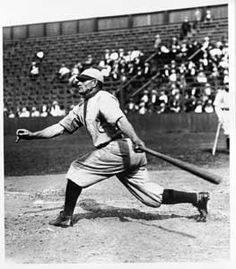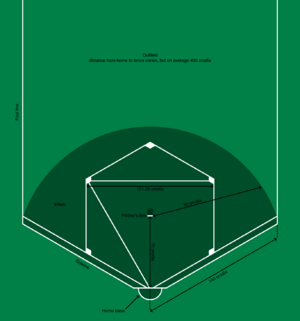Bganveli
 A bganveli player after hitting the ball with his bat. | |
| Highest governing body | World Bganveli Association |
|---|---|
| First played | 45th-century Fugireu (predecessors) 46th-century Dhimrai (modern version) |
| Characteristics | |
| Contact | Tagging-only |
| Team members | 10 (on defense) |
| Mixed-sex | No |
| Type |
|
| Equipment | Bganveli ball Bganveli bat Bganveli glove Batting helmet |
| Venue | Bganveli field |
| Presence | |
| Country or region | North Yazland Yasgan colonial empires |
| World Games | Demonstrated in 4598 |
Bganveli (Dhimze: bgánveli lit. 'shelter ball') is a bat-and-ball sport played between two teams of 10 players each, taking turns batting and fielding. The game occurs over the course of several plays, in which the offense tries to score by hitting the ball successfully and running through the bases, while the defense tries to put the batter and runners out.
Name
The name bganveli comes from Dhimze bgáni "shelter, safe haven" and veli "ball".
History
Playing field

The infield (omápar) is hexagonal, with each side being 70 orodia (18.20 m) in length. The starting point of the hexagon is a semicircle 25 orodia (6.50 m) in diameter known as home base (bgáni). Each subsequent point of the hexagon is known as a base (imzhe), first through fifth. There are two lines running through the hexagon: one connecting second and fourth base, known as the steal path (vánebáks;-lm), and another connecting fourth and home base, known as the home path (bgániks;-lm). At the center of the hexagon is the pitcher’s line. The infield extends a further 70 orodia from the hexagon on either side of home base, constituting the diameter of a semicircle delimiting the infield’s boundaries. This semicircle is such that the edge is 90 orodia (23.40 m) from the pitcher’s line. A strip called the sideline (pusiks;-tesv) extends 8.5 orodia (2.21 m) along the edge of infield’s inner boundary. After the infield extends the outfield (oknipár), delimited by two straight lines known as the foul lines (ábukedit;-tesv). There is no official regulation on the outer limit of the outfield, but on average the outer wall is located around 400 orodia (104 m) away from home base. The field can be composed of light dirt, sand or sometimes grass.
Rules
Offense
Play begins at home base, with a batter from the offensive team standing ready to bat. The opposing team’s catcher is crouched behind him, and the pitcher faces him from the pitcher’s line. The goal of the pitcher is to strike out the batter by throwing the ball within the strike zone (veoniks;-mzháni), which is roughly defined by the space between the two sidelines and extending vertically between the batter’s knees and his armpits. The pitcher must run up to the pitcher’s line before pitching, which is characterized as two hops or steps before the ball leaves the pitcher’s hand on the third. Any pitch thrown within the strike zone is called a strike (ubrcvit;-veoni) and any pitch thrown outside is called a ball (soqit;-veoni). Any pitch resulting in a swing and miss from the batter is considered a strike. Three strikes retire a batter, known as an out (ntetv), while three balls advance the batter to first base, known as a walk (vineb). The most advanced runner on base will also advance on a walk (that is, if there are runners on second and fourth base, the runner on fourth base will advance to fifth base).
Defense
The goal of the batter is to hit the pitched ball into play with his bat. The played ball must hit the ground within the foul lines to be considered a fair hit. A ball that first hits the ground beyond either foul line or the outfield wall is a foul ball (ábukedit;-veli), which counts as a strike. If a ball is caught before it hits the ground by a defending player, the batter and all runners are out, though this only registers as a single out. If the hit is fair, the batter then becomes a runner and needs to run around the bases as quickly as possible before the ball is thrown to the next base. If a runner is off base and the ball is in control of a defensive player on the next base, that runner is out (that is, if a runner is attempting to run to first base and a defensive player with the ball in hand steps onto first base, the runner is out). The goal of runners is to run around the bases counter-clockwise when the ball is in play to arrive back at home base, which scores a run (veqeb). If a runner manages to run the bases back to home base on his hit ball, this is referred to as a home run (bgánit;-veqeb). Not every base needs to be hit by the runner, as third and fifth base can be skipped, though this comes at a risk. The steal path being longer than the path from second to third base, which leaves the runner exposed for longer, and he will be out if a defensive player with the ball in hand steps onto fourth base. Likewise, the home path is the same length as the steal path, with the added risk that a defensive player only needs to step onto fifth base with the ball in hand to get the runner out. If a runner reaches a base before a defensive player can get him out, he is considered safe (bgánit;).
Match structure
A regular game of bganveli is played in 8 innings (smeeb), where both teams take turns batting in their offensive half-inning. Whichever team is first to bat is decided at the start of the game with a coin toss. Innings last until three runners are out, or if 9 batters have gone up without at least 2 runs scored. Whichever team has scored the most runs at the end of an inning is awarded one point, and the team with the most points at the end of the game wins. If the game is tied after 8 innings, an extra 9th inning is played. Rules vary between leagues on what happens if the game is still tied after 9 innings, but generally a “golden goal” round is initiated where each team starts with a runner on fourth base.
Equipment
All players are required to wear a shirt, which can have short or long sleeves but must have buttons, and a pair of pants. The shirt must be tucked inside the pants. Each player is also required to wear a helmet when playing in an offensive inning, which protects the ears, forehead and back of head. A glove is used to ease catching the ball when playing on defense, which is made of leather and is webbed between the thumb and index finger. Players use a wooden bat to hit the ball. There is no standard on length, weight or center of gravity, but the maximum legal length is 35 rdavia (91 cm). The ball used in bganveli has a diameter of 2.5 rdavia (6.50 cm) and a circumference of around 7.85 rdavia (~20.42 cm). The weight of the ball is less consistent, but generally weigh around [150–160 g][TBA Yasgan units].